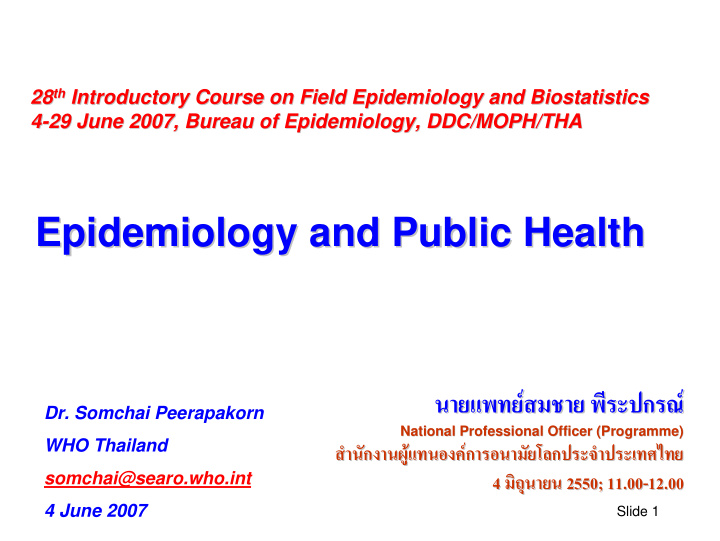



th Introductory Course on Field Epidemiology and Biostatistics 28 th Introductory Course on Field Epidemiology and Biostatistics 28 4- -29 June 2007, Bureau of Epidemiology, DDC/MOPH/THA 29 June 2007, Bureau of Epidemiology, DDC/MOPH/THA 4 Epidemiology and Public Health Epidemiology and Public Health นายแพทยสมชาย พีระปกรณ พีระปกรณ นายแพทยสมชาย Dr. Somchai Peerapakorn National Professional Officer (Programme) National Professional Officer (Programme) WHO Thailand สํานักงานผูแทนองคการอนามัยโลกประจําประเทศไทย สํานักงานผูแทนองคการอนามัยโลกประจําประเทศไทย 4 มิถุนายน มิถุนายน 2550 2550; 11.00 ; 11.00- -12.00 12.00 4 somchai@searo.who.int 4 June 2007 Slide 1
Points: Points: • Know more about – Epidemiology – Public Health – Health • How those words link to us as professionals Slide 2
The original map drawn by Dr. John Snow (1813-1858), a British physician who is one of the founders of medical epidemiology, showing cases of cholera in the London epidemics of 1854, clustered around the locations of water pumps. http://en.wikipedia.org/wiki/Epidemiology Slide 3
Epidemiology… ….(1) .(1) Epidemiology • …is the field of medicine concerned with the determination of causes, incidence, and characteristic behavior of disease outbreaks affecting human populations. http://healthweb.org/browse.cfm?categoryid=1502 • …is the study of how often diseases occur in different groups of people and why . http://www.bmj.com/epidem/epid.1.html Slide 4
Epidemiology… ….(2) .(2) Epidemiology • …is the study of “4 Ds” – Distribution, Dynamics, Determinants of Diseases - among human populations • …is the study of factors affecting the health and illness of populations, and serves as the foundation and logic of interventions made in the interest of public health and preventive medicine. http://en.wikipedia.org/wiki/Epidemiology • etc. Slide 5
Epidemiology… ….(3) .(3) Epidemiology • All findings must relate to a defined population –population at risk. –Target population � study population � study sample • Oriented to groups rather than individuals –quality of data • Conclusions are based on comparisons –comparing disease rates in groups with differing levels of exposure Slide 6
Public Health… …(1) (1) Public Health • …is the science and art of preventing disease, prolonging life and promoting health through the organised efforts and informed choices of society, organisations, public and private, communities and individuals. Winslow from Modern Medicine in 1920 • …refers to all organized measures (whether public or private) to prevent disease, promote health, and prolong life among the population as a whole. http://www.who.int/trade/glossary/story076/en / Slide 7
"Health care matters to all of us some of the time, public health matters to all of us all of the time" C. Everett Koop Slide 8
Public Health… …(2) (2) Public Health • Protect and improve… • Focuses on entire populations rather than individuals… • Proactive, preventive approach… Public Health regards the community as its patient http://www.whatispublichealth.org/what/index.html Slide 9
Slide 10 is… … ” is Health” “Health “
Conclusion: Conclusion: …Professionals need to study and use the principles and methods of Epidemiology to guide essential Public Health policies and actions, targeting to achieve Health for all the people. Slide 11
Thank you… Thank you… … Thank you Slide 12 www.who.int www.who.int
Recommend
More recommend